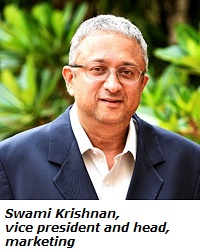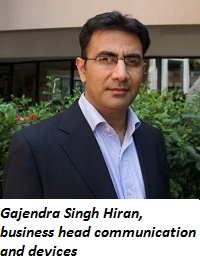Sasken Communication Technologies is a design services company with an expertise in wireless communications.
Swami Krishnan, vice president and head, marketing and Gajendra Singh Hiran, business head, communication and devices, talk to Priya Ravindran of EFY for the Design in India series.
Q. Could you introduce Sasken to us?
A. Sasken communications is a 25 year old company specialising in design and analysis (D&A) in product engineering services. We offer end-to-end services for product development, with capabilities of transforming paper-specifications into a finished product. Our focus areas are the automotive sector, the Internet of Things and wireless communications, pertaining to both semiconductor and mobile device domains.
(D&A) in product engineering services. We offer end-to-end services for product development, with capabilities of transforming paper-specifications into a finished product. Our focus areas are the automotive sector, the Internet of Things and wireless communications, pertaining to both semiconductor and mobile device domains.
Q. Could you tell us about the embedded design services you offer?
A. Our services range from specifications to design for manufacturability (DFM). Typically, product design starts from choosing the right semiconductor for the application. We then develop software on top of it – this could be in terms of board support packages and reference drivers, port the operating system and develop required applications. We also provide hardware design services in parallel, right from the schematic to the printed circuit board layout stage.
Q. Who would be your partners to aid with the design process?
A. For the components side of things, we partner with aggregators from Taiwan, Hongkong  and China. From the manufacturing side, original design manufacturers (ODMs) like Celestica, Sanmina help us deliver finished goods to our customers.
and China. From the manufacturing side, original design manufacturers (ODMs) like Celestica, Sanmina help us deliver finished goods to our customers.
Q. Could you tell us about your Intellectual Property (IP) development capabilities?
A. We develop our own IPs, which we then license to our customers. We have developed a complete multimedia framework with a variety of different encoders and decoders, catering to different platforms. We have our own application framework, SAF, a user-customisable operating system. We have also extensively worked with wireless communications – typically modems and protocols and have developed our own protocol stack for 2G, 3G, including time division synchronous code division multiple access (TD-SCDMA).
Q. Tell us about the multimedia solutions you provide.
A. We provide our multimedia framework as an IP and build complete solutions around it with services like development of applications and integrating the system with third-party components. Our multimedia solutions target three major domains. Mobile phones today host a variety of codecs, rendering different kinds of audio, video and images. In the automotive sector, we have in-vehicle, in-dash infotainment with audio and video playback applications. With the advent of Android and other high-level operating systems, we offer our services to smart television providers to good effect.
Q. Talking about smart, could you take us through your work in the Internet of things (IoT) arena?
A. IoT is essentially an extension of machine-to-machine (M2M) solutions and we began with work in this area with ConnectM, about six to seven years ago. The idea took off for producing interesting solutions in the telecom space. With billions of mobile users in India, the assets called mobile towers are spread about, with some even in rural areas or near highways. Monitoring these assets be it from a security point of view, monitoring the periphery of the towers for safety purposes or making sure that they do not run out of resources like diesel for generators becomes important. Monitoring the electronic health of the infrastructure also comes to the fore here. We make this information centrally available to people, which can then be used to take preventive or breakdown action.
Also, there is a focus on managing areas from an energy point of view, in accordance with our central energy management system that helps in managing energy according to needs. We have also worked in making custom modules for monitoring high-value assets like machinery to avoid standstill owing to breakdowns.
So, with all this work, if we just take out the sensor layer, bring in computing and connectivity, and make sense of the data obtained, we would have a complete IoT package. With the currency of IoT rightly being called ‘data’, we are building an analytics system that looks promising. We have capability right from semiconductor level and have developed solutions with collarations to enable IoT products.
Q. What are the new IoT enabled products you are working on?
A. We are working on IoT enabled radio frequency identification (RFID) tags that can go into shoes. We have also worked with smart metering.
There is also a ski-jacket within which we have embedded a tracking mechanism. With skiing being a sport where people can easily get lost, we have worked at a combination of cellular and global positioning system (GPS) protocols to make sure the location of the person is always traceable.
We are also focusing on developing personal safety devices that would be wearables, so to say, to monitor the safety of the wearer of the device, with respect to who he/she interacts with. It could be used to make sure kids do not go beyond a certain perimeter and old people or people with ailments do not wander off forgetfully. In such scenarios, the device would trigger an alarm to alert the concerned person.
Q. How would you be connecting your IoT enabled solutions to the cloud?
A. IoT is a developing field where collaboration is the key. We are working with partners for cloud infrastructure and data analytics, semiconductor companies that are developing specialised IoT chips for the computing side of things and using our wireless solutions to enable connectivity among these areas.
Q. What parameters do you take into account while deciding the kind of wireless approach to close in for a particular application?
A. The choice of the wireless protocol would depend on the quantum of data, frequency of communication, the location of the device, proximity or distance factors, the amount of tampering it might undergo and ruggedness of the device.
Q. What are the challenges in developing rugged devices?
A. The challenge lies in the design and implementation, from both the hardware and the software perspective. Take the example of a satellite phone used by a hiker or an optical character recognition (OCR) system used by a FedEx delivery person. The device cannot afford to hang or stop, the battery has to provide substantial power and there has to fail-safe mechanisms to take over the operation in case of failure. The devices will have to be fail-proof and the testing process is rigorous. There are also standards that the devices will have to comply with, including dust-proof, waterproof requirements. While developing these devices, it is necessary to be aware of the use-cases.
Q. What would be your opinion of hardware versus software solutions?
A. Hardware solutions, say inbuilt into the chip-level, would be more secure and hack-proof. But taking into account the cost of research and development (R&D), ease of maintenance and longevity of products; change is inevitable and it becomes that much more difficult to implement in hardware. With standards still evolving, it would be prudent to stick to software solutions, until a guaranteed standard is arrived at.
Q. Talking about standards, you happen to be a member of a lot of telecommunication standards groups. How does Sasken work in the area of standards?
A. We have earlier contributed to the development of standards. We worked with the test specification part of the Third Generation Partnership Project 2 (3GPP2). We are also looking at further works in this area, which would keep us in the game in all parts of the product development life cycle. We also have capabilities for the test and measurement (T&M) aspect of these standards.
Q. Would you offer testing as an exclusive service?
A. Yes. Testing, verification, validation, quality assurance – the whole stack is an important aspect of design services, and it goes hand-in-hand with the design process. About 30 per cent of our revenue comes in from our testing services, which include feature and functional testing. Testing has moved from manual testing to test-gig creation, test automation, test-suites and we create test assets and test cases. We offer design verification for chip companies, which includes block level and system level, as well as IP verification. Also, on the device side, we have testing for certification of these devices.
Q. What would be the strength of your team?
A. We are a team of about 2000 people. We are welcome to recruit engineers, mainly in the development side, who can work on embedded R&D, testing and verification, application data services and infrastructure management.






